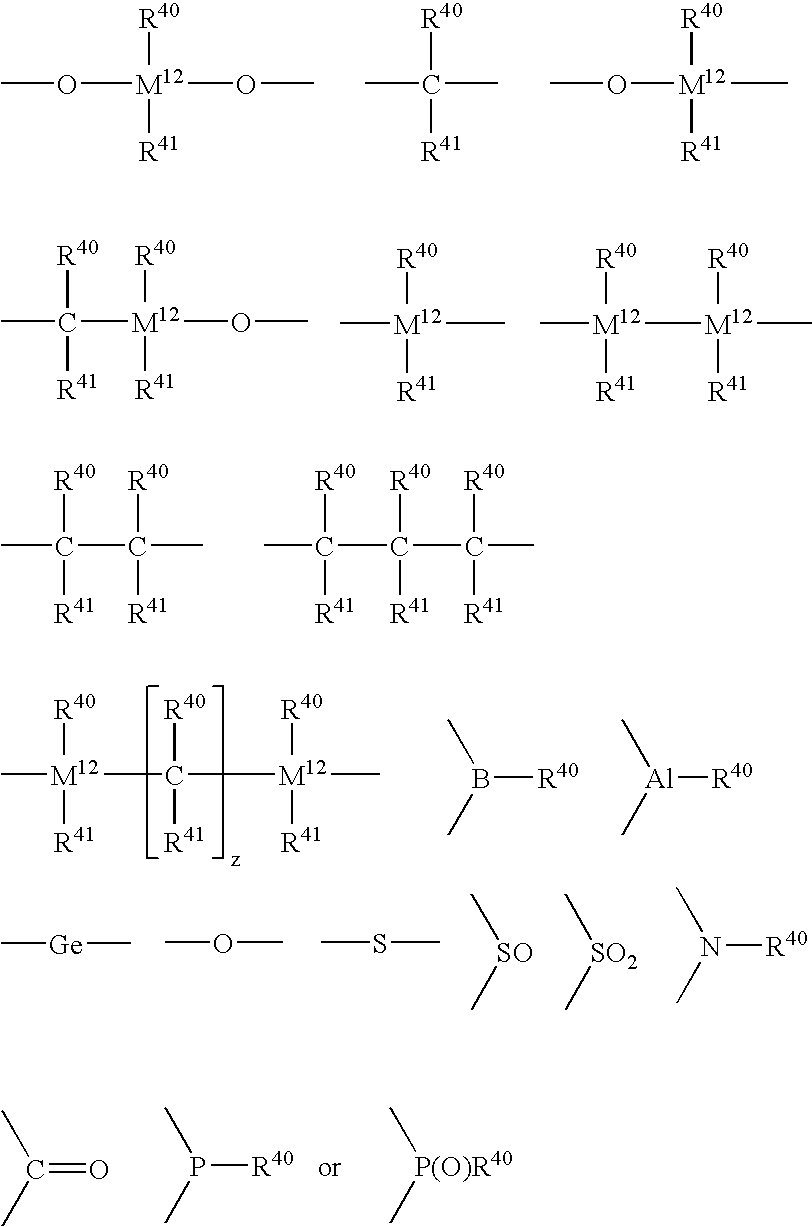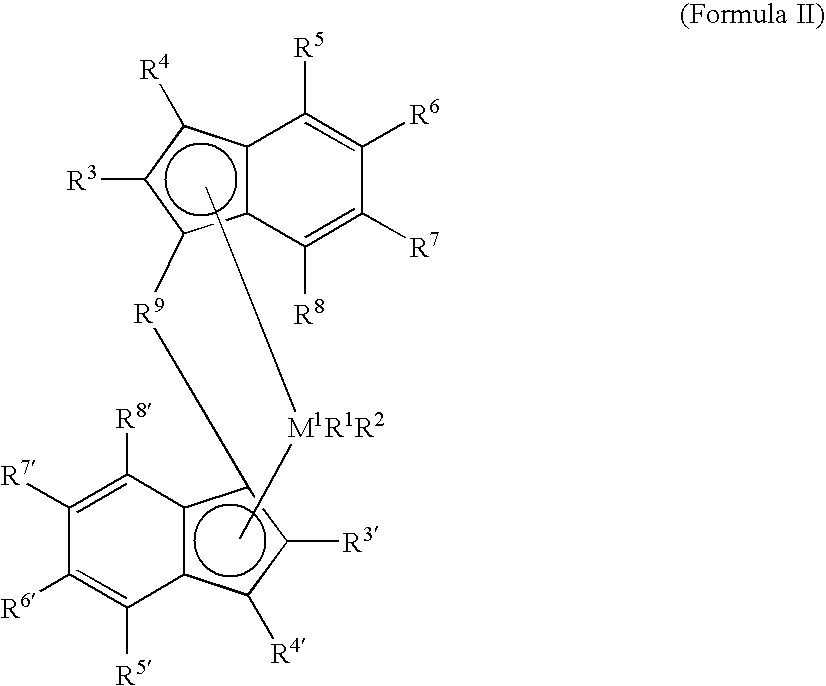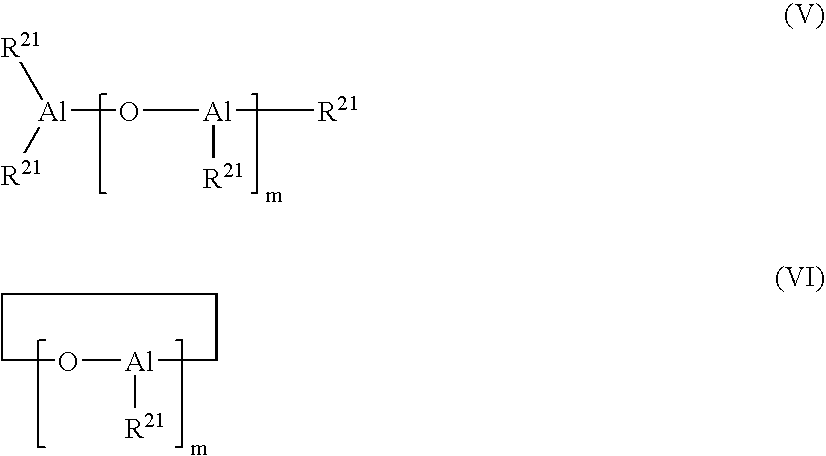[0025] The composition of the invention provides a better balance of SIT, level of solubles and mechanical properties compared to prior art. Furthermore, only up to 40 wt % of the lower
crystallinity material has to be produced in a second
polymerization reactor or step. On top of that, the amount of
comonomer that has to be incorporated into the low
crystallinity fraction of the composition, is significantly lower than in prior art of comparable SIT. This is a significant improvement for the vertically stirred
gas phase process where production of compositions with properties of the invention was not possible yet. A further significant
advantage is the nature of the solubles: whereas in prior art the solubles were of low
molar mass, the solubles of the invention are high molecular weight. This means that at relatively high levels of
xylene solubles, the food relevant FDA
hexane extractables are extraordinary low. Another
advantage of the present invention is the fact that its compositions comprise ultra low
crystallinity fractions not present in prior art compositions. These ultra low crystallinity compositions provide excellent heat-sealing behavior.
[0026] Compared to EP 263 718-B1, the levels of
xylene solubles and
hexane extractables of the compositions of the present invention are lower. Compared to the compositions disclosed in EP 483 523-B1, the levels of hexane extractables of the compositions of the present invention are lower. Furthermore, whereas in the compositions of EP 483 523-B1 between 35 and 70 wt % of low crystallinity component are required, in the compositions of the present invention the amount of low melting material is between only 5 and 40 wt %. The amount of low crystallinity material required in the composition of the present invention is less compared to EP 560 326-B1 and EP 674 991-B1 where between 40 and 80 wt % of low crystallinity material are required. Furthermore, compared to the compositions of EP 560 326-B1, the balance between the SIT and the level of extractables is better in the present invention, and compared to EP 674 991-B1, the levels of extractables and the SITs are lower in the compositions of the present invention. Compared to WO 00 / 11076 where between 20 and 80 wt % of the low crystalline component need to be present and, where in addition a peroxidic degradation step has to be employed in order to yield low extractables and SIT values, in the compositions of the present invention the amount of low melting material is maximum 40 wt % and no peroxidic degradation step is required. This facilitates the production of the composition of the present invention tremendously. Furthermore, the compositions of the present invention exhibit lower levels of extractables than the compositons disclosed in WO 00 / 11076. Compared to EP 780 432-B1, the amount of
comonomer that has to be incorporated into the radncom
copolymer produced in the first reactor is significantly lower in the present invention. Thus, production problems like reactor
fouling are much less likely. Furthermore, in the compositions of the present invention, the SIT values are significantly lower at same or lower amount of solubles. Compared to random copolymers disclosed in EP 881 239-B1 and WO98 / 58971, the SIT of the present invention is significantly lower at same or lower level of extractables. Compared to WO 02 / 44251, SIT and level of extractables are much lower in the present invention, at similar film stiffness. Compared to EP 982 328-B1, the compositions provided in the present invention can be used as the sole component of a sealing layer in a mono-, bi- or multi-layer cast or biaxially oriented film due to their low-enough MFR and lower levels of extractables.DETAILED DESCRIPTION OF PREFERRED EMBODIMENT(S)
[0027] The invention relates to copolymer compositions of propylene random copolymers with at least one more C2-C20-α-olefin other than propylene which is particularly suited, inter alia, for the manufacture of films or film
layers using any film-making process, particularly processes for making cast film and biaxially oriented film. The films or film
layers of the present invention exhibit very low proportion of extractables, very low seal
initiation temperature, and a good balance of stiffness,
toughness and transparency.
Polymer films used for packaging and wrapping (particularly in the
food industry) are generally multilayered having, for example, a
polypropylene (homopolymer or copolymer) layer and at least one sealing layer. The blend of polypropylene copolymers disclosed herein is advantageously employed as a sealing layer for such films. For the purpose of the present invention, non-propylene C2-C20-α-olefins are
ethylene or linear or branched α-olefins that have from 4 to 20 carbon atoms. Prefererence is given to
ethylene and linear α-olefins. Particular, but non-limiting examples are ethylene, 1-
butene, 1-
pentene, 1-
hexene, 4-methyl-1-
pentene and 1-
octene. The
copolymer composition consists of from about 60 weight percent to about 95 weight percent of a first random copolymer of propylene and at least one non-propylene C2-C20-α-olefin and of about 5 weight percent to about 40 weight percent of a second random copolymer of propylene and at least one non-propylene C2-C20-α-olefin.
[0028] It is usual for customary amounts of conventional additives, such as stabilizers, lubricants, mold-release agents, fillers, nucleating agents, antistats, plasticizers, dyes, pigments or
flame retardants to be added to the polypropylene composition prior to its use. These are usually incorporated into the
polymer during pelletization of the
polymerization product produced in pulverulent form. The usual stabilizers are antioxidants, such as sterically hindered
phenols, process stabilizers, such as phosphites or phosphonites, acid scavengers, such as
calcium stearate,
zinc stearate or dihydrotalcite, sterically hindered amines, or else UV stabilizers. The novel polypropylene composition generally comprises amounts of up to 2% by weight of one or more of the stabilizers. Examples of suitable lubricants and mold-release agents are fatty acids, the
calcium or
zinc salts of the fatty acids, fatty amides and low-molecular-weight
polyolefin waxes, and these are usually used in concentrations of up to 2% by weight. Examples of suitable nucleating agents are inorganic additives, such as
talc, silica or kaolin, salts of mono- or polycarboxylic acids, such as
sodium benzoate, aluminum tert-butylbenzoate or disodium norbornanedicarboxylate, dibenzylidenesorbitol or its C1-C8-
alkyl-substituted derivatives, such as bis(p-methyl-benzylidene)
sorbitol) or bis(3,4-dimethylbenzylidene)
sorbitol, salts of diesters of
phosphoric acid, such as
sodium 2,2′-methylenebis(4,6-di-t-ert-butylphenyl)
phosphate, amides of dicarboxylic acids, such as N,N′-dicyclohexylnaphthalinedicarboxamide, and
rosin based nucleating agents. The content of nucleating agents in the propylene
polymer composition is generally up to 5% by weight. Additives of this type are generally commercially available and are described, for example, in Zweifel (Ed.), Plastics Additives Handbook, 5th Edition, Hansa Publishers, Munich, 2000.
[0029] One embodiment of the invention relates to copolymer compositions of propylene random copolymers with at least one more C2-C20-α-olefin other than propylene. The first random copolymer is characterized in that its propylene content is from above 90 to about 99.5 weight percent and in that it contains at least one more C2-C20-α-olefin. Preferred C2-C20-α-olefins are ethylene, 1-
butene, 1-
pentene, 1-
hexene, 4-methyl-1-pentene and 1-
octene. Particularly preferred C2-C20-α-olefins are ethylene and 1-
butene. Preferred first random copolymers are C3 / C4 random copolymers, C3 / C2 random copolymers and C3 / C2 / C4 random copolymers, and particularly preferred first random copolymers are C3 / C2 random copolymers. The first random copolymer is furthermore characterized in that its
melting point is from above 116° C. and up to about 145° C., and in that its MFR is from above 2 g / 10 min to about 12 g / 10 min. The first random copolymer is furthermore characterized in that it is produced by means of a
metallocene catalyst.
[0030] The second random copolymer is characterized in that its propylene content is from above 85 to about 97 weight percent and in that it contains at least one more C2-C20-α-olefin, and in that the propylene content of the second random copolymer is always lower than the propylene content of the first random copolymer. Preferred C2-C20-α-olefins are ethylene, 1-butene, 1-pentene, 1-
hexene, 4-methyl-1-pentene and 1-
octene. Particularly preferred C2-C20-α-olefins are ethylene and 1-butene. Preferred second random copolymers are C3 / C4 random copolymers, C3 / C2 random copolymers and C3 / C2 / C4 random copolymers, and particularly preferred second random copolymers are C3 / C2 random copolymers. The second random copolymer is furthermore characterized in that it has a melting point of from about 70° C. to no more than 116° C. The second random copolymer is furthermore characterized in that it has a melting
enthalpy from about 10 J / g to no more than 75 J / g, said melting
enthalpy arising from the melting of crystals of polypropylene random copolymers. The second random copolymer is furthermore characterized in that its MFR is from above 2 g / 10 min to about 12 g / 10 min. The second random copolymer is furthermore characterized in that it is produced by means of a
metallocene catalyst.
 Login to View More
Login to View More 


